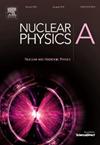Symmetry energy and its correlations with the nuclear structure properties of Z=40 isotopic series at finite temperature
IF 2.5
4区 物理与天体物理
Q2 PHYSICS, NUCLEAR
引用次数: 0
Abstract
Symmetry energy is an important quantity in studying the nuclear structure, dynamics of heavy-ion reactions, and physics of neutron stars. The equation of state of asymmetric nuclear matter is limited due to the undetermined symmetry energy and lack of initial constraints on the nuclear matter (NM), leading to a study of the symmetry energy of NM. In this work, we have studied the temperature-dependent nuclear symmetry energy (S) of Zr isotopic series with N=34-86 along with its volume () and surface components () using the Coherent Density Fluctuation Model (CDFM). The nuclear densities used as input to CDFM are calculated along with the bulk properties at finite temperature within the temperature-dependent Relativistic Mean Field Model using NL3 and IOPB-I interactions. The ground state bulk properties are in good concurrence with the available experimental data. The binding energy per nucleon and neutron pairing energy decrease, and the radial density distribution increases with a rise in temperature (T). The deformed nuclei with an increase in T become spherical at and beyond the critical temperature. The bulk properties exhibit the magicity of N=40 along with the standard neutron magic numbers in this range at T=0 MeV. The nuclear symmetry energy, its surface and volume components, and their ratios show a similar behavior change as that occurring in the nature of deformation with the neutron number N. As IOPB-I interaction predicts a softer equation of state than NL3 (stiffer), the symmetry energy of the nuclei corresponding to IOPB-I is comparatively less. The symmetry energy of Zr isotopic series is found to be correlated with nuclear structure properties at finite temperature. The symmetry energy is maximum at N=50, even at finite temperature, as this isotope possesses the highest stability in the Zr series. This study will help in the production of exotic nuclei and the understanding of heavy-ion reactions.
有限温度下Z=40同位素系的对称能及其与核结构性质的关系
对称能是研究核结构、重离子反应动力学和中子星物理的一个重要量。由于对称能的不确定和对核物质缺乏初始约束,使得非对称核物质的状态方程受到限制,从而对核物质的对称能进行了研究。本文利用相干密度涨落模型(CDFM)研究了N=34-86的Zr同位素系列的核对称能(S)、体积(SV)和表面组分(SS)随温度的变化规律。利用NL3和IOPB-I相互作用,在温度依赖的相对论平均场模型中计算了作为CDFM输入的核密度以及有限温度下的体性质。基态体积特性与现有实验数据吻合较好。随着温度(T)的升高,每核子的结合能和中子的配对能减小,径向密度分布增大。随着T的增加,变形核在临界温度及以上变成球形。在T=0 MeV时,体性质表现出N=40的神奇性以及该范围内的标准中子神奇数。核对称能、其表面和体积分量及其比值κ表现出与中子数n的变形性质相似的行为变化。由于IOPB-I相互作用预测的状态方程比NL3更软(更硬),因此与IOPB-I相对应的核对称能相对较少。发现Zr同位素系的对称能与有限温度下的核结构性质相关。对称能在N=50时最大,即使在有限温度下也是如此,因为该同位素在Zr系列中具有最高的稳定性。这项研究将有助于外来核的产生和对重离子反应的理解。
本文章由计算机程序翻译,如有差异,请以英文原文为准。
求助全文
约1分钟内获得全文
求助全文
来源期刊

Nuclear Physics A
物理-物理:核物理
CiteScore
3.60
自引率
7.10%
发文量
113
审稿时长
61 days
期刊介绍:
Nuclear Physics A focuses on the domain of nuclear and hadronic physics and includes the following subsections: Nuclear Structure and Dynamics; Intermediate and High Energy Heavy Ion Physics; Hadronic Physics; Electromagnetic and Weak Interactions; Nuclear Astrophysics. The emphasis is on original research papers. A number of carefully selected and reviewed conference proceedings are published as an integral part of the journal.
 求助内容:
求助内容: 应助结果提醒方式:
应助结果提醒方式:


